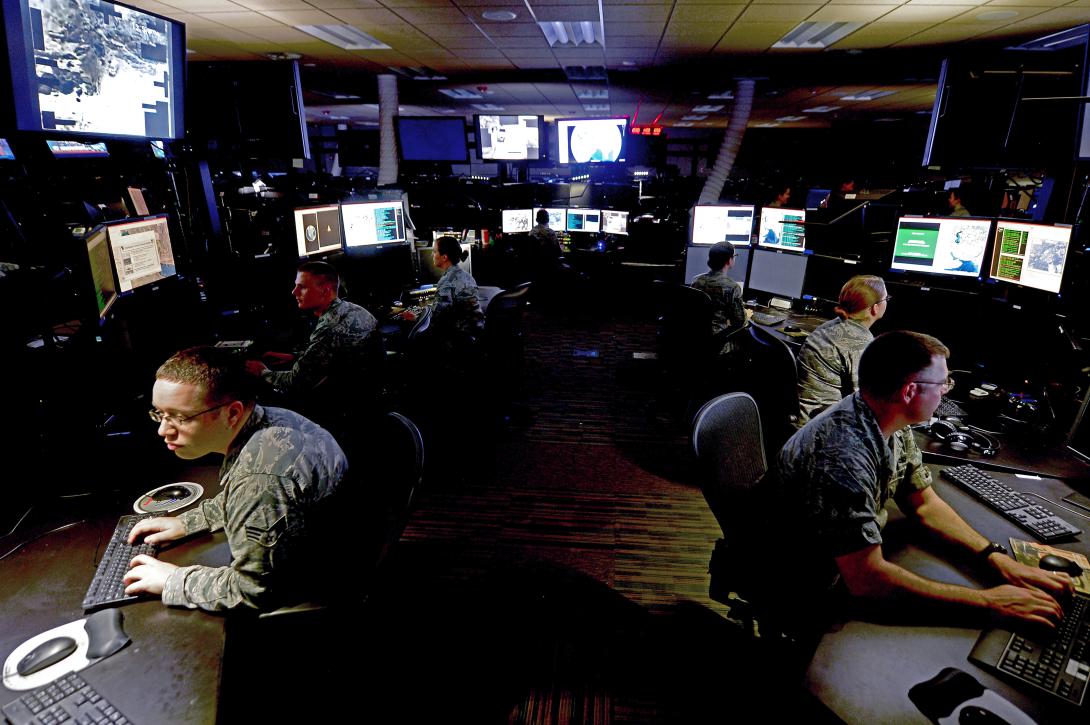In Vast Oceans of Data, AI Extracts the Pearls
The U.S. Air Force is deploying a new open architecture for its primary intelligence, surveillance and reconnaissance system. At the same time, Air Force researchers are developing deep learning capabilities that will allow the decades-old system to sort through reams of data more easily, enabling faster decision making on the battlefield and enhancing multidomain command and control.
An Air Force fact sheet describes the Air Force Distributed Common Ground System (AF DCGS) as a planning and direction, collection, processing and exploitation, analysis and dissemination weapon system. The system employs a global communications architecture that connects multiple intelligence platforms and sensors. Airmen assigned to AF DCGS produce actionable intelligence from data collected by various sensors on the U-2, RQ-4 Global Hawk, MQ-1 Predator, MQ-9 Reaper and other intelligence, surveillance and reconnaissance (ISR) platforms.
The system evolved from ISR programs dating back to the late 1960s but traces its direct lineage to the Contingency Airborne Reconnaissance System established in 1992 at Langley Air Force Base, Hampton, Virginia. Since its early inception, it has grown from a deployable system to a distributed ISR operation capable of providing nearly real-time intelligence worldwide to multiple theaters of operation simultaneously.
The new open architecture developed at the Air Force Research Laboratory, Rome, New York, offers infrastructure as a service. “The Open Architecture Distributed Common Ground System is one common hardware and software core. It provides a standardized hardware and software platform with a modern, cloud-ready infrastructure and a government-owned baseline,” says Daniel Goddard, director, Information Directorate, Air Force Research Laboratory.
Capabilities can be easily migrated to the new architecture, but the Open Architecture Distributed Common Ground System (OA DCGS) also will allow much more rapid and efficient adoption of future capabilities. Goddard says the system will essentially become a “conveyor belt” for new capabilities. “This will give us increased operational agility and increased cyber resiliency. In the end, we believe it will reduce the test time by 80 percent and allow us to deliver capabilities 93 percent faster than they can be today,” he states.
He adds that the 93 percent increase is an aggressive goal that will take time to reach. He also emphasizes that more than technology is behind the ability to field systems more rapidly. “It is about the technology but also about understanding the acquisition process and procedures. You can develop a platform that is standardized. From a technological standpoint, you have an open architecture to develop on, but then you have to understand how the platform will help speed you through the acquisition process,” Goddard says.
One new capability planned for the OA DCGS is a deep learning technology known as AIDE, or Artificial Intelligence Discovery and Exploitation. The system will sift through “oceans of data,” he says, looking for the pearls of information most relevant to warfighters. “There’s currently a huge burden on our airmen to manually sift through data and find the information crucial for good situational awareness and decision making,” Goddard explains. “We must have the capability to identify, analyze and provide the right information at the right time to the right decision makers. It’s critically important to the success of any mission.”
AIDE determines an analyst’s needs by ingesting, processing and analyzing requests for information. It discovers new information by performing object detection and imagery-to-text captioning from multidomain ISR data sources. AIDE then compares the new information against the needs of the analyst and automatically pushes notifications directly to the analyst.
“We believe advances in computational intelligence will help shift the burden of search, annotation and aggregation and analysis from airmen to artificial intelligence,” Goddard says. “AIDE reduces the time to discover potentially relevant information in air, space and cyberspace for the analyst, freeing up time for them to do what they do best—analysis.”
He cites several statistics to illustrate the big data challenge. Every day about 3.6 exabytes (3.6 quintillion bytes) of brand new information are created globally. In one minute on the Internet, YouTube receives a few hundred hours of video and about 5 million video views, according to some estimates. Also, people send 450,000 new tweets, Goddard says. In that same minute, he adds, the Air Force exploits, processes and reasons through thousands of gigabytes of data. “We’re only at the beginning of an exponential growth of ideas, applications and uses of information. Information generated exceeds the human capacity to reason over it in a timely manner. For our airmen, we believe we must create and harness advances in machine intelligence to help rewrite the rulebook,” Goddard asserts.
Air Force officials evaluated the AIDE technology in December during an Air Force Lab event known as TechFest. AIDE will be further matured before being integrated into the OA DCGS.
Faster intelligence analysis has a ripple effect that ultimately enables more effective multidomain command and control, commonly referred to as MDC2. MDC2 is one of three focus areas for the Air Force outlined last year by the service’s chief of staff, Gen. David L. Goldfein, USAF. “While we dominate the air, space and cyber domains today, our adversaries have invested heavily in technologies to deny us the superiority we have come to rely upon. To counter this, we must integrate our advantages across these domains in new and dramatically effective ways,” the general says in a paper published last year on the subject. “Linking operations moving at the speed of light with operations moving at the speed of sound requires we bring it all together: the skills of our airmen, the vision of our leaders, and the audacity and technical innovation found throughout Air Force history.”
The OA DCGS is currently being fielded at 27 sites worldwide, Goddard reports. It will take two or more years to complete the process, in part to avoid any disruption for warfighters. “You must do it seamlessly so that the warfighter doesn’t see it. It’s really important that we do it in a way that there’s no impact to existing capability,” he offers.
His team conducts both near- and long-term research to help enable MDC2 “at the speed and scale necessary to outmaneuver our opponents,” Goddard indicates.
MDC2 is global command and control across the air, space and cyber domains. “Multidomain command and control sounds easy. It’s not. First, you have to have assured, secured communications in a contested environment. You’ve got to have cyber under control, or you’re not going to have secure or assured communications,” Goddard says. “You’ve got to have a way of sifting through all of that data. You have to take that data and turn it into decisions, and all of that requires processing power.”
To meet the challenge, the lab’s Information Directorate has identified six areas of technological emphasis: multidomain command and control; agile, assured and secured communications and networks; cyberspace superiority; artificial intelligence, autonomy and machine learning; data to decisions, or big data analytics; and processing power provided through extreme computing.
“To power multidomain command and control in order to power cyberspace superiority or any of these things, you’re going to have to go through the oceans of data. You must have processing power. Whether it’s neuromorphic computing, whether it’s quantum computing, or whether it’s some type of hybrid computing, we in the Information Directorate are pursuing extreme computing techniques to power the capabilities the Air Force will need in the future,” he says.






Comments